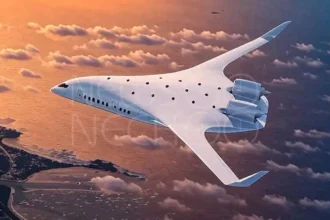Tragedy at Dubai Airshow
A showcase of aviation excellence turned into heartbreak on Friday when an Indian Air Force Tejas fighter jet crashed during an aerial display at the Dubai Air Show, claiming the life of its pilot and casting a shadow over one of the world’s premier aviation events.
DUBAI – What began as a day of celebration and technological prowess at the prestigious Dubai Air Show ended in tragedy when an Indian Air Force Tejas fighter jet went down during an aerial performance. The incident occurred at Al Maktoum International Airport at Dubai World Central, where thousands of spectators had gathered to witness some of the world’s most advanced military aircraft demonstrate their capabilities.
The crash, which took place on Friday during a flying display, resulted in the death of the pilot—a loss that has sent shockwaves through the Indian Air Force and the international aviation community. The pilot’s identity has not yet been publicly released, as authorities work to notify family members and conduct their investigation.
The Moment Everything Went Wrong
Witnesses at the airshow described watching the Tejas fighter jet perform what appeared to be routine aerial maneuvers when something went terribly wrong. According to reports, the aircraft suddenly entered a steep decline—a moment that immediately signaled to experienced observers that the pilot was in serious trouble.
In aerial displays, precision and control are everything. Pilots train for years to execute complex maneuvers at high speeds while maintaining complete mastery of their aircraft. But on Friday, that control was lost in a matter of seconds. The Tejas, India’s indigenously developed light combat aircraft, descended rapidly before crashing at the airshow venue.
Emergency response teams on the ground moved swiftly. Firefighting crews and medical personnel rushed to the crash site, but the impact proved fatal for the pilot. The speed and violence of the crash left little chance for survival.
India’s Response: Deep Regret and Solidarity
The Indian Air Force released an official statement acknowledging the tragedy with somber words that reflected both the loss of a fellow servicemember and the pain of a military family grieving one of its own.
“An IAF Tejas aircraft met with an accident during an aerial display at Dubai Air Show, today. The pilot sustained fatal injuries in the accident. IAF deeply regrets the loss of life and stands firmly with the bereaved family in this time of grief,” the statement posted on X (formerly Twitter) read.
The measured language of the official statement couldn’t mask the profound loss. Behind the formal words lies a pilot who dedicated their life to serving their country, who trained countless hours to master one of India’s most sophisticated aircraft, and who was representing the nation on an international stage when disaster struck.
For the Indian Air Force, this represents not just the loss of a skilled aviator but also a stark reminder of the risks that military pilots face every time they climb into a cockpit—whether in combat zones or at airshows designed to showcase their skills.
UAE’s Swift Response
The United Arab Emirates government, hosting the prestigious Dubai Air Show, moved quickly to address the incident. The UAE’s Ministry of Defence confirmed the accident and praised the rapid response of emergency teams.
“A Tejas fighter aircraft from India participating in today’s flying display at the Dubai Airshow has crashed, resulting in the tragic death of the pilot,” the Ministry stated on X, acknowledging the severity of the incident.
The UAE government also emphasized that “firefighting and emergency teams responded rapidly to the incident and are currently managing the situation on-site.” The quick deployment of emergency services reflects the extensive safety protocols that major airshows maintain precisely for such worst-case scenarios.
Dubai’s Al Maktoum International Airport, where the show was taking place, is one of the world’s most modern aviation facilities. The airshow venue is equipped with comprehensive emergency response capabilities, which were activated immediately following the crash.
The Tejas: India’s Indigenous Fighter
The aircraft at the center of this tragedy is the Tejas, a light combat aircraft that represents a significant achievement in India’s defense manufacturing capabilities. Developed by Hindustan Aeronautics Limited (HAL) and the Aeronautical Development Agency (ADA), the Tejas has been a source of national pride—India’s first indigenously designed and manufactured fighter jet.
The Tejas program has been decades in the making, with the aircraft designed to replace aging Soviet-era fighters in the Indian Air Force fleet. It’s a multi-role light fighter capable of air-to-air combat, ground attack missions, and reconnaissance. The jet features modern avionics, a digital fly-by-wire flight control system, and the ability to carry a variety of weapons.
Participation in international airshows like Dubai serves multiple purposes for India. It demonstrates the capabilities of indigenous defense technology, attracts potential foreign buyers, and showcases India’s growing aerospace industry on the global stage. The Dubai Air Show, one of the world’s largest and most prestigious aviation events, draws military and civilian aviation professionals from around the world.
Friday’s crash now raises questions about what went wrong with the Tejas during its display—questions that investigators will work methodically to answer in the coming weeks and months.
What Happens Next?
Following any aircraft accident, especially one involving a military jet at an international event, a comprehensive investigation must take place. Investigators will examine every aspect of the incident:
The aircraft’s maintenance records: Was the Tejas properly serviced before the display? Were there any known mechanical issues?
Flight data and recordings: Modern fighter jets are equipped with sophisticated data recording systems that track every parameter during flight. This “black box” information will be crucial.
Pilot actions: What maneuvers was the pilot attempting? Did they follow standard procedures? Were there any deviations from the planned display routine?
Environmental factors: Weather conditions, wind patterns, and other environmental factors at the time of the crash will be analyzed.
Witness accounts: Statements from other pilots, ground crew, and spectators will help piece together the sequence of events.
The investigation will be thorough and methodical. In aviation, understanding what went wrong isn’t just about assigning blame—it’s about preventing future tragedies. Every crash investigation potentially saves lives by identifying issues that can be corrected.
The Human Cost of Aviation
It’s easy to focus on the technical aspects—the aircraft specifications, the investigation procedures, the diplomatic responses. But at the heart of this tragedy is a human being who lost their life doing what they were trained to do.
Military pilots are among the most highly trained professionals in any country’s armed forces. They undergo years of rigorous training, psychological testing, and continuous skill development. They understand the risks but choose to fly anyway because they believe in their mission and their service.
The pilot who died on Friday was representing not just the Indian Air Force but the entire nation at a prestigious international event. They were showcasing India’s technological achievements and military capabilities. They were doing their job with skill and dedication when something went catastrophically wrong.
Now, somewhere in India, a family is receiving the worst possible news. Parents, perhaps a spouse, maybe children—people who kissed their loved one goodbye and expected them to return home safely after the airshow. Instead, they’re preparing for a funeral and trying to comprehend an incomprehensible loss.
A Shadow Over the Airshow
The Dubai Air Show continued after the crash, but the incident inevitably cast a somber mood over the event. Airshows are celebrations of human achievement in aviation, demonstrations of skill, precision, and technological advancement. But they’re also reminders of how unforgiving aviation can be when things go wrong.
For the other pilots participating in the show, the crash serves as a stark reminder of the thin margin between a successful display and disaster. Every pilot at that airshow understands that they could have been in that cockpit. It’s a sobering thought that likely made every subsequent takeoff and landing a little more tense.
Remembering the Sacrifice
As investigations continue and official procedures unfold, it’s important to remember that behind the headlines and official statements is a real person who made the ultimate sacrifice. The pilot who died in Dubai was serving their country, representing India with pride, and performing a mission they had trained extensively to execute.
The Indian Air Force’s statement that it “stands firmly with the bereaved family” reflects more than institutional sympathy—it’s a reminder that military service creates a family bound by shared sacrifice and mutual support.
In the coming days, more details will emerge about what happened in those final moments before the Tejas crashed. Investigators will analyze data, examine wreckage, and eventually provide answers. But no amount of technical explanation will bring back the pilot who died, or ease the pain of the family left behind.
For now, the aviation community mourns one of its own, taken too soon in service of their nation.











